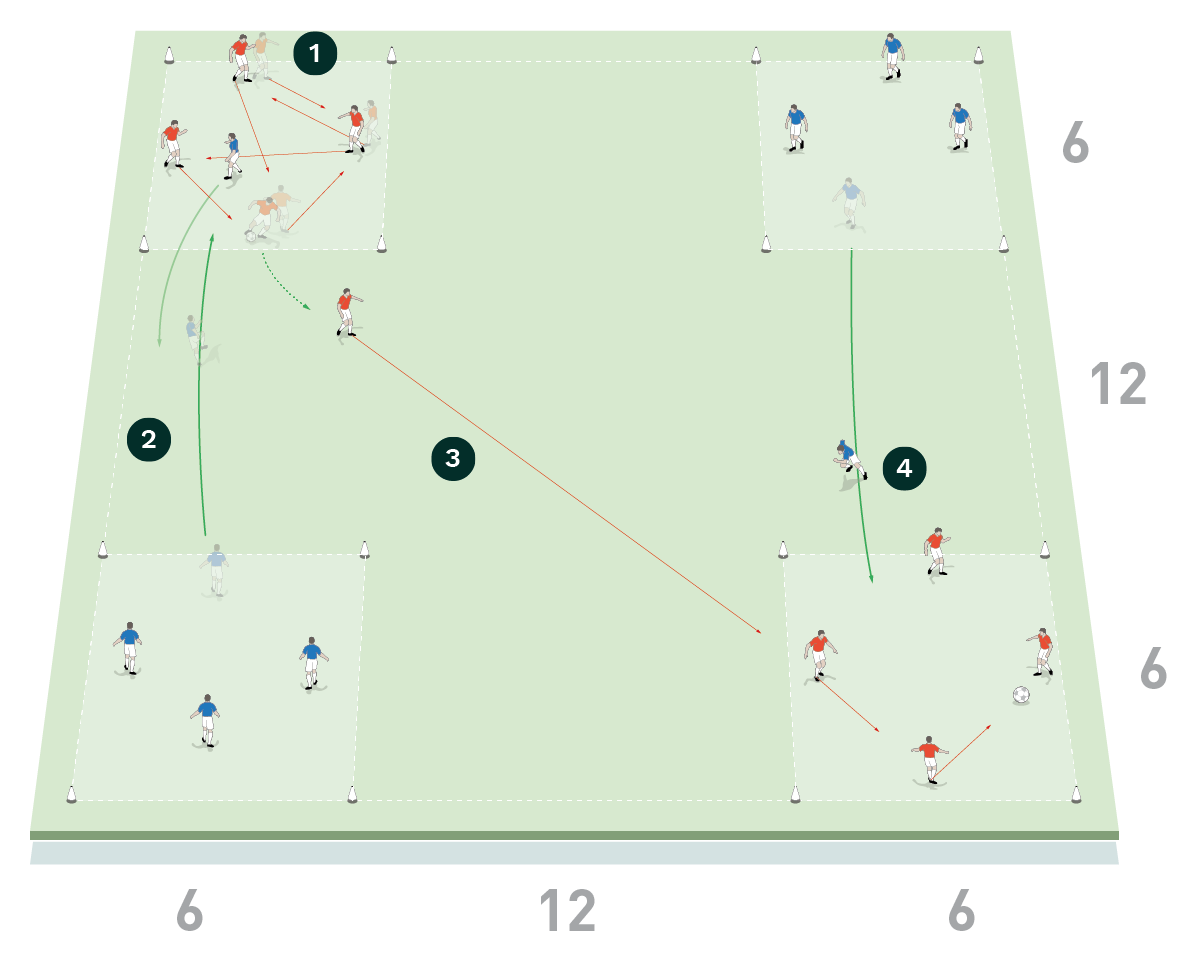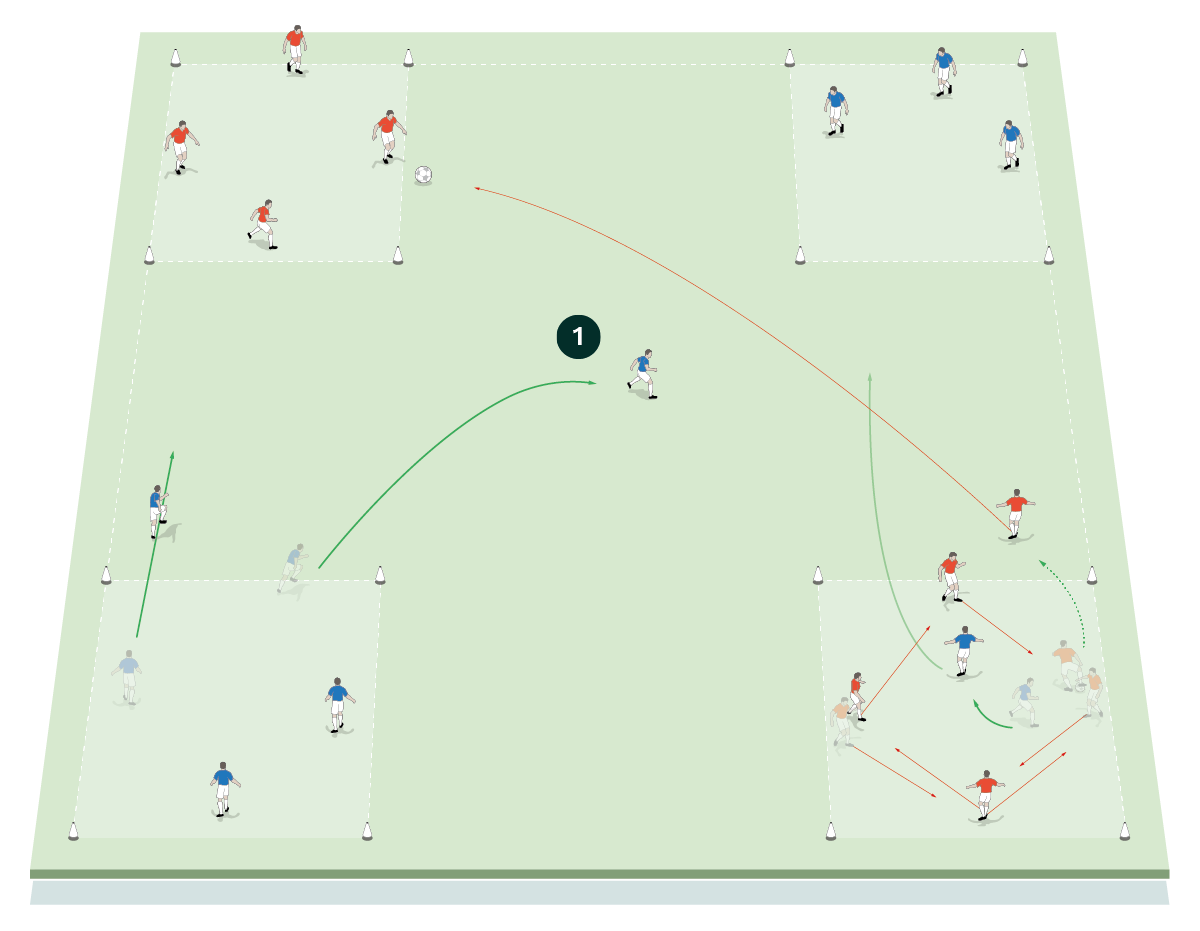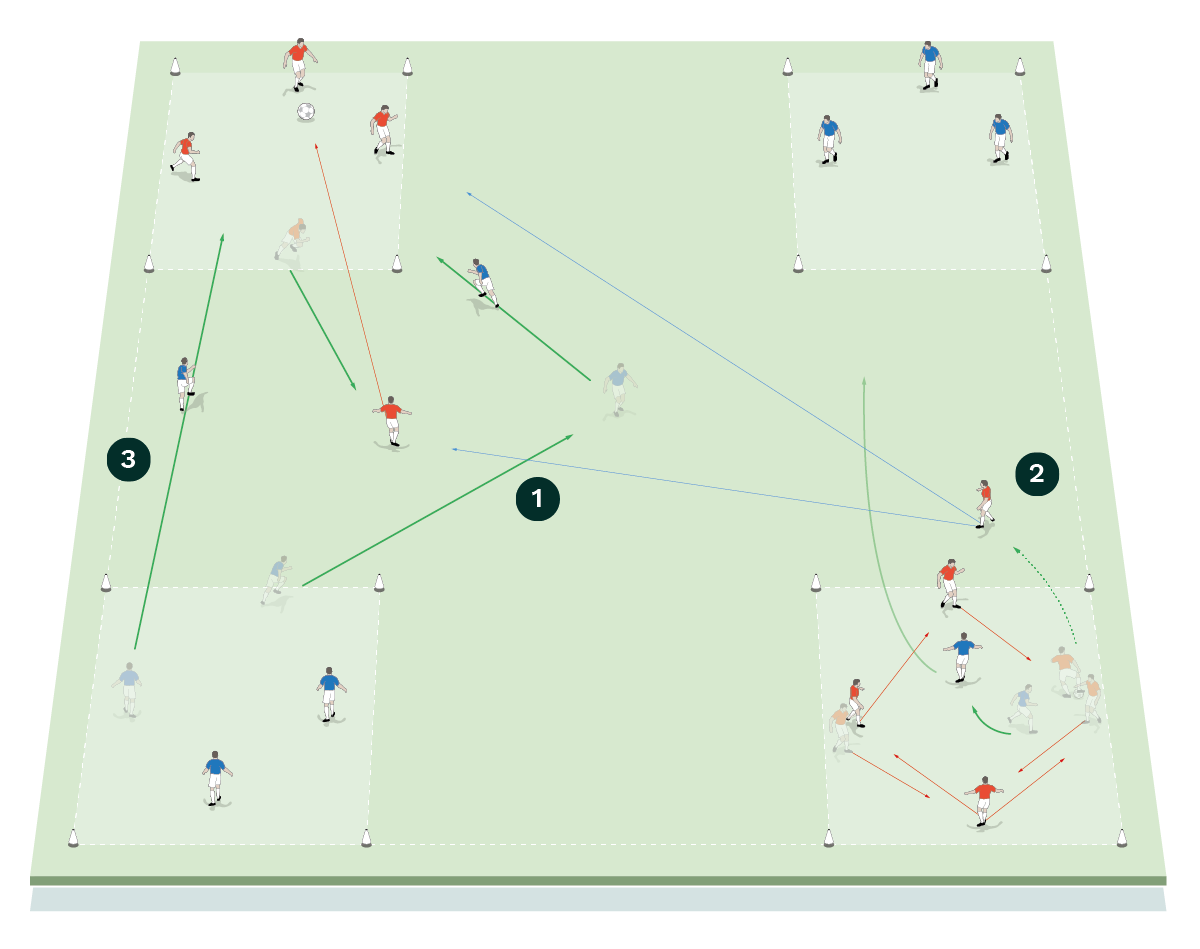You are viewing 1 of your 1 free articles
Possession and transition
| Area | 24x24 yards |
| Equipment | Balls, bibs, cones |
| No. of Players | 16 players |
| Session Time | Total activity: 25mins |
This easy to set up training activity is all about keeping hold of the ball in tight areas. It helps players to understand the pressing need to be alert to their chances to break out of the rondo in order to switch the play.
It’s a simple activity that keeps the players thinking about the next move they should make and it offers them plenty of opportunities to transition.
It can also offer players a real sense of competition if a scoring system is employed.
We would use this activity just once a month in order to keep it fresh and we would tend to run it when we want to get a training session off to a fast start, performing it directly after a warm-up.
“This is an activity that keeps the players thinking about the next move they should make”
FOUR BOX GAME
We set up a playing area of 24x24 yards, with four 6x6-yard rondo boxes marked out in the corners, each spaced 12 yards apart from the next box, as shown.
We’re using 16 outfield players split into two teams of eight. Four players start in each of the corner rondo boxes. The red team starts in possession in one of the corner boxes and they must make six consecutive passes before they can break out of the box.
The reds pass under pressure from one of the blues who runs into the active box to press and tries to win possession. If the reds succeed in stringing six passes together, the player who breaks out of the box then aims to switch the play across to the other reds in the box diagonally opposite. The blues react by sending a defender into the new active box to press the reds who have received the switch of play, as shown [1a].
[1a]

- The red team starts in possession in one of the corner boxes. They must make six consecutive passes before they can break out
- The blues send a player into the active rondo box to press the red passing team
- After the reds make six passes, a player breaks out of the box and switches the play to the other reds in the box diagonally opposite
- The blues react by sending a defender into the new active box to press the reds who have received the switch of play
The activity continues with the possession team always aiming to make six passes before breaking out to switch play diagonally across the playing area. If the blues win the ball, they should clear it out of the area and play restarts with the reds again.
As a progression, we allow a defender from the blue out-of-possession team to come into the centre of the main playing area and attempt to stop the diagonal switch of play, as shown [1b].
[1b]

- As a progression, a defender from the blue out-of-possession team is allowed to come in to the centre and attempt to stop the diagonal switch of play
As a second progression, we could allow a player from the red team to drop into the central area from the box without the ball in order to combine with the breakout player. On breaking out of the active rondo box the player on the ball would now have a decision to make between playing the long switch directly into the box diagonally opposite as before, or playing a pass to the team mate who has dropped into the central area, who would complete the switch of play with another pass. The practice would then continue as before, but now two defenders can go to press in an active passing box to create a 4v2 situation in favour of the team in possession, as shown [1c].
[1c]

- As a further progression, a red from the box without the ball can drop into the central area to receive from the breakout player if needed
- The red player who breaks out now has two options: switching the play directly or combining with the player in the centre to switch the play
- In another progression, two blue defenders can now go to press in the active passing box to create a 4v2 situation
The final progression is free play and the red players can now move anywhere to create the combinations needed to switch the play, which will naturally create more chaos and therefore offer more decision making opportunities for the players, as shown [1d].
[1d]

- The final progression is free play. Players can now move anywhere to create the combinations needed to switch the play from corner to corner
“The final progression is free play and the red players can now move anywhere to create the combinations needed to switch the play”
Similarly, the blues would also be allowed to move anywhere to try and stop the switch of play.
We would run the activity for four blocks of five minutes, adding progressions, lifting restrictions or rotating players after each block.
COACHING POINTS
What are the key things to look out for?
We want to see players scanning and getting on the half turn to receive the ball. We also want to see good quality passing and clever combination play.
What are the typical mistakes players might make and how do I avoid them?
Typical mistakes include players not getting on the half turn when breaking out of the corner rondo box and running into defenders. Other mistakes include players not picking the best moments to break out of the corner box and forcing the switch of play when a pass is not on.
How would I put this into a game situation?
We could make it a game by adding goals and encouraging a break out but after the switch of play, the possession team would finish on goal.
Related Files
Editor's Picks
Using the goalkeeper in build-up play
Pressing principles
Intensive boxes drill with goals
Penetrating the final third
Creating and finishing
My philosophy
Pressing initiation
Compact team movement
Defensive organisation
Coaches' Testimonials

Alan Pardew

Arsène Wenger

Brendan Rodgers

Carlos Carvalhal

José Mourinho

Jürgen Klopp

Pep Guardiola

Roy Hodgson

Sir Alex Ferguson

Steven Gerrard
Coaches' Testimonials

Gerald Kearney, Downtown Las Vegas Soccer Club

Paul Butler, Florida, USA

Rick Shields, Springboro, USA

Tony Green, Pierrefonds Titans, Quebec, Canada
Join the world's leading coaches and managers and discover for yourself one of the best kept secrets in coaching. No other training tool on the planet is written or read by the calibre of names you’ll find in Elite Soccer.
In a recent survey 92% of subscribers said Elite Soccer makes them more confident, 89% said it makes them a more effective coach and 91% said it makes them more inspired.
Get Monthly Inspiration
All the latest techniques and approaches
Since 2010 Elite Soccer has given subscribers exclusive insight into the training ground practices of the world’s best coaches. Published in partnership with the League Managers Association we have unparalleled access to the leading lights in the English leagues, as well as a host of international managers.
Elite Soccer exclusively features sessions written by the coaches themselves. There are no observed sessions and no sessions “in the style of”, just first-hand advice delivered direct to you from the coach.









